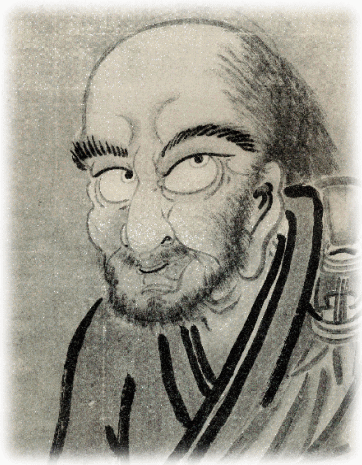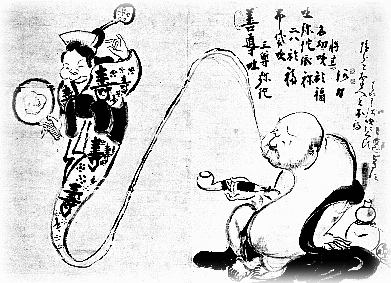
This is not to say that these subjects are unimportant. Hakuin’s artwork, in particular, has been a major part of his legacy, and has attracted considerable interest in the years since the Meiji Restoration. During the pre-WWII period, the Japanese art collectors Yamamoto Hatsujirō 山本発次郎 and Hosokawa Morisada 細川護貞 attempted to obtain and preserve as many of Hakuin’s paintings as they could, while literati like Mushanokoji Saneatsu 武者古路実篤 and Okamoto Kanoko 岡本かの子 evaluated the master’s work from an aesthetical standpoint. International interest in Hakuin’s paintings increased following WWII, commensurate with the growing Western interest in Zen and the publication of influential books like Kurt Brasch’s Zenga (1961).
It is not an exaggeration to say that from Meiji times on Hakuin’s reputation has spread primarily as a result of interest in his paintings and calligraphy. This interest in Hakuin’s art is something to be commended, of course, but it is unfortunate that its interconnection with other aspects of the master’s legacy have gone largely unnoticed. Hakuin was not simply an artist, producing paintings independently from his writings. He was, in everything he did, first and foremost a religious teacher, and it is important not to overlook this.
Hakuin’s art was described by the philosopher Hisamatsu Shin’ichi 久松真一 with adjectives like “powerful,” “solid,” “profound,” “penetrating,” “settled,” “severe,” and other terms suggestive of a bold, decisive style. In a discussion of Sengai Gibon 仙厓義梵 (1750-1837), Hisamatsu writes:
The Zen style of Hakuin was truly impressive. Hakuin started a revolution, so much so that present-day Zen can be called “Hakuin Zen.” He didn’t simply pass on Zen as it was before, but produced what amounts to a new type of Zen, and that is an important accomplishment. He not only taught many students, but left numerous writings, among them the Kaiankoku go, Keisō dokuzui 荊叢毒蘂, the various kana hōgo, and many more full-length books; Hakuin’s Complete Works form an enormous body of material.
With paintings too, Hakuin produced many works that reflect his approach to Zen. Sengai’s style of Zen, compared with that of Hakuin, was much inferior, much subordinate. So I personally don’t think it’s especially meaningful to contrast the two approaches and discuss their differences.
Comparing their respective paintings, the differences in the two artists’ styles are evident I think. One senses a great strength permeating Hakuin’s works, and they have an immovable solidity about them, like that of a huge rock. In his depictions of Bodhidharma, for example, the First Patriarch has a sense of size, weight and penetrating vigor that is truly remarkable. Hakuin’s paintings are profound, penetrating, and large in scale, in addition to which they have a settled, seasoned quality. Sengai’s work is light and carefree, open and unrestrained, but it lacks penetration, scale, and the other qualities of Hakuin’s art. The lightness, openness, and freedom of Sengai’s paintings are, I think, reflections of Sengai’s character — he must have been a man of quick and ready wit, and this manifests itself not only in his paintings but the inscriptions he wrote on them. Hakuin too had wit, of course, but Sengai’s wit was lighter, and he must have used this in teaching his monk and lay disciples.
Other commentators express largely the same opinion of Hakuin. Okamoto Kanoko writes:
Viewing Hakuin’s work, the first thing one senses is the overwhelming power, the vigorous energy that imbues it. Next is the almost living passion with which the master’s will is expressed. The tone is one utterly different from the detached, unrestrained quality that typifies most zenga. Hakuin’s style is an expression of his powerful physique and personality, but it also reflects Hakuin’s deep religious view that true life is to be found only in everyday reality and human nature. It is an expression, too, of the ultimate principles of Mahayana Buddhism.
The very force and rawness of Hakuin’s work causes some people to regard it as coarse and lacking in tranquility, but that is a matter of personal taste. In my opinion, Hakuin’s sketches are among the few Japanese works of recent centuries that match Western drawings in the sense of strength they convey. They remind me of the drawings of Michelangelo, or (though the use of line is different) of Albrecht Duerer or William Blake.

It is true that a number of Hakuin’s works can be described in this way. Viewing the works at the beginning of this section and immediately above, anyone — Asian or European, male or female, young or old — would have much the same impressions as Hisamatsu or Okamoto.

Nevertheless, not all of Hakuin’s works are of this type. The paintings referred to by art critic Takeuchi Naoji as giga 戯画 (“cartoons,” or, more literally, “joke pictures”) — like the hell pictures in which one of the Ten Kings of the Underworld appears in red underwear — fit few of the characteristics listed by Hisamatsu. These paintings, incidentally, are further examples of the lack of serious research on Hakuin’s art. Takeuchi may have described them as “jokes” out of a failure to understand their true meaning; in any event it is the case that their religious significance has never been examined from a historiographical standpoint. The most they have received are arbitrary interpretations at the hands of Hakuin aficionados.
In any event, these paintings are not comics, but are profound religious messages expressed with all of Hakuin’s powers of artistic creativity and technique. Attempts to understand them intuitively on the basis of aesthetic sensitivity or religious perception can never reveal their true inner meaning. Only familiarity with the entire body of Hakuin’s work can provide the context necessary for discerning what these paintings are trying to convey.
Unfortunately, for nearly two and a half centuries after Hakuin’s death the messages of his paintings have remained largely closed. Our understanding of this important master will be limited until his artwork is reinterpreted within the framework of Hakuin’s thought as expressed in his goroku and kana hōgo. What is certain to become clear from such study is the burning passion of this great religious figure. If we can see how timeless were the issues he dealt with and how creative and varied were the ways in which he addressed them, the wisdom he displayed is certain to inspire in us new approaches to the problems we face today.